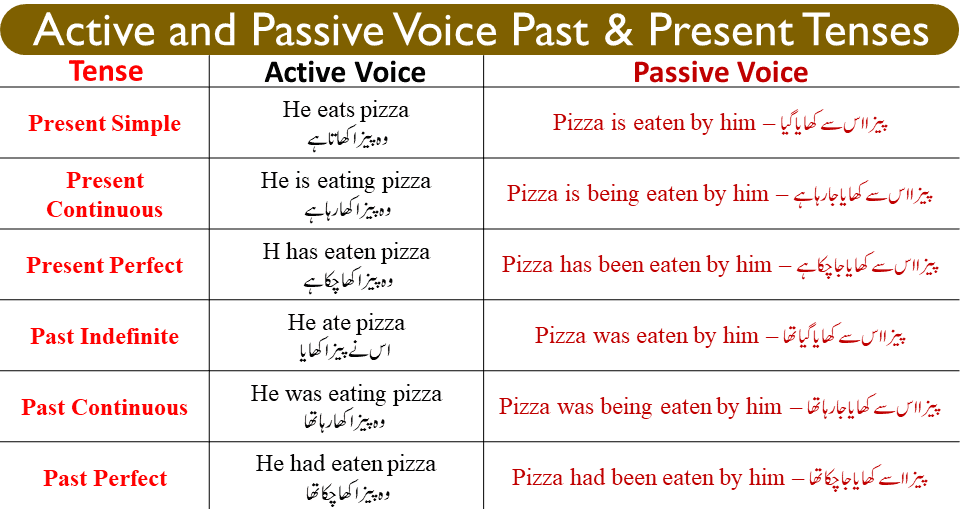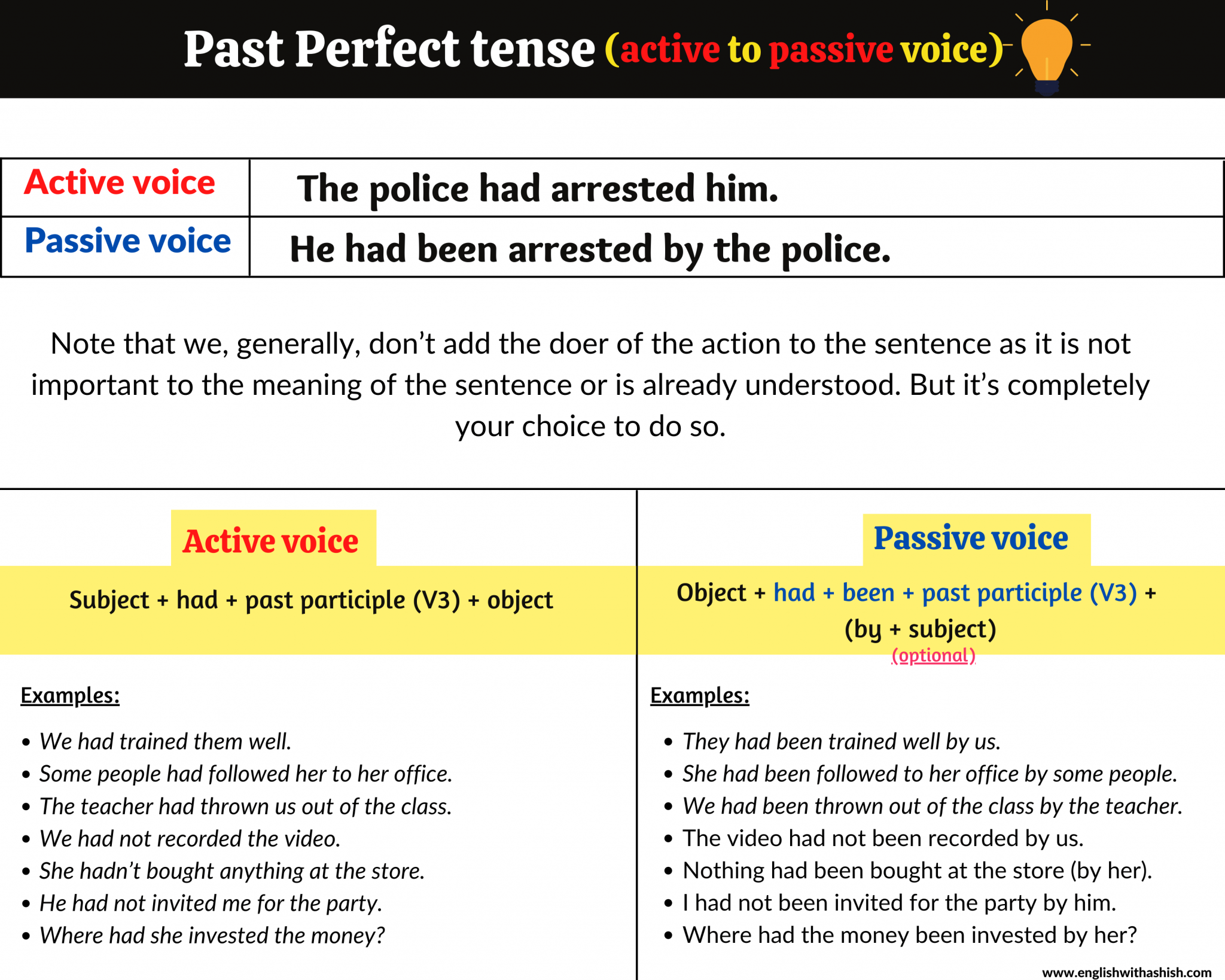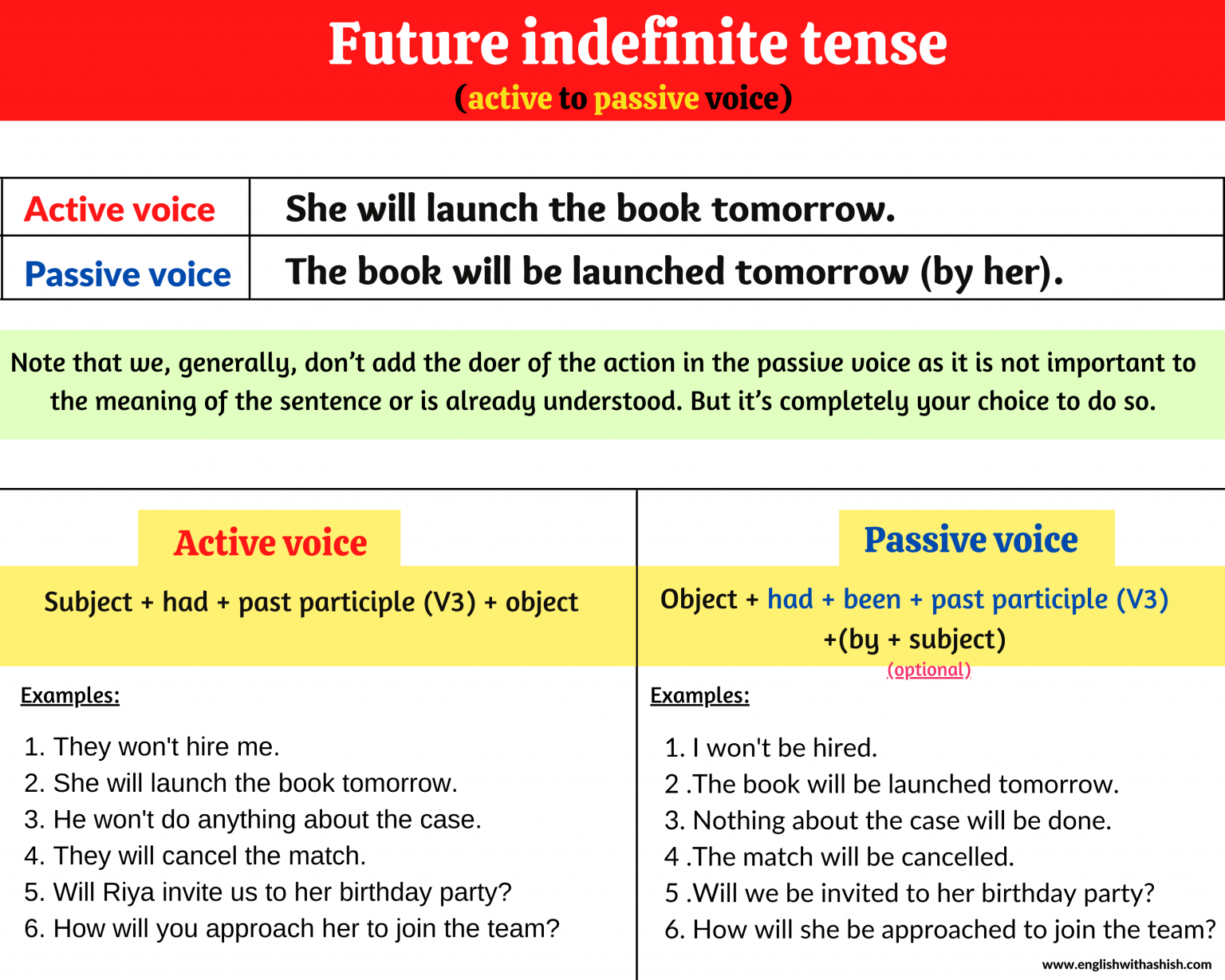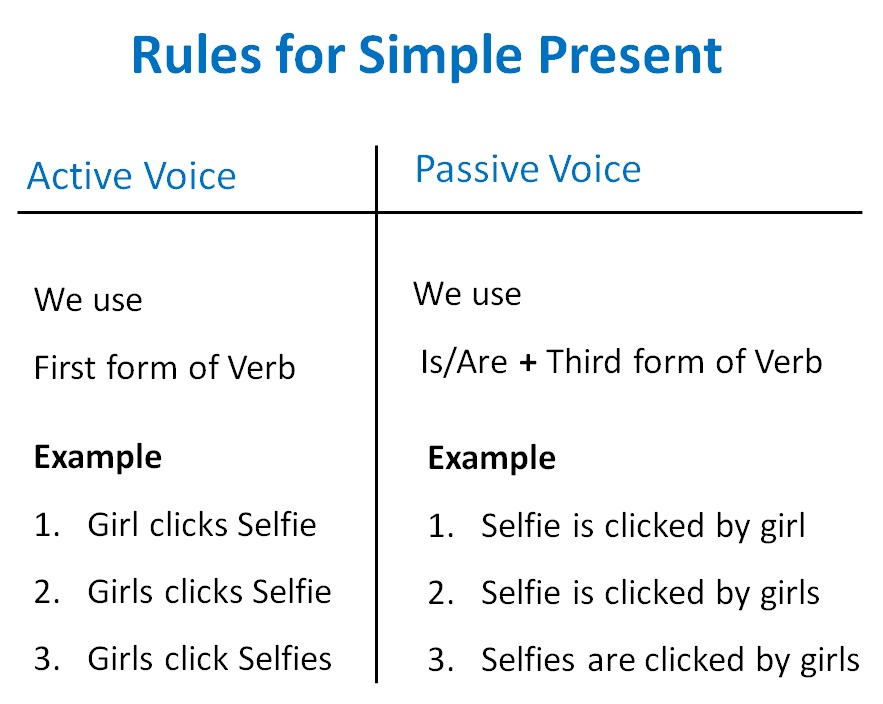
Simple Present Tense Present Indefinite Tense Rules And Examples Riset
We sometimes use the verb get with a past participle to form the passive: Be careful with that glass. It might get broken. Peter got hurt in a crash. We can use the indirect object as the subject of a passive verb: Active. Passive. I gave him a book for his birthday. He was given a book for his birthday.

Active And Passive Voice Examples For All Tenses Table of Contents Active And Passive Voice
Passive Voice for all Tenses - Rules. There are two basic rules for converting sentences from active voice into passive voices, which apply to all tenses. The places of the subject and the object in a sentence are interchanged for converting active voice into passive voice. Only 3rd form of the verb (e.g., written) is used as the main verb in.

Simple Present Tense Examples Active And Passive / Present Indefinite Tense Passive Voice
Look at the following examples: My friends appreciate my work. (Active voice) Subject = my friends Verb = appreciates Object of the verb = my work My work is appreciated by my friends. (Passive voice) Subject = my work (the receiver of the action) Verb phrase = is appreciated Doer (original subject) =my friends

Active and Passive Voice Rules and Examples English and Urdu
Active and Passive Voice in Past Indefinite Tense: Examples and Exercises | English Grammar Mcqs"In this video, we will explore the difference between active.

Active to Passive voice in the Past Perfect tense
Examples of passive voice: My bike was stolen last night. We were told not to park the car in front of the building. The students were allowed to use the calculator in the exam. Mini was loved by everyone. I was called on the stage to participate in an activity. Why was she fired from her previous job? Where were you called to discuss the plan?

Passive Voice Present Simple Active And Passive Voice Teaching My XXX Hot Girl
The simple past tense is one of these tenses which is used to refer to actions that are completed in a period of time before the present. The passive voice of simple past tense is formed by using the auxiliary verb "was/were" and the past participle of the main verb. The object of the active sentence becomes the subject of the passive sentence.

Pin on Passive Voice Tenses
Active and Passive Voice Rules and Exercises (Past Indefinite Tense) Active and Passive Voice Rules and Exercises (Past Indefinite Tense) By admin | April 4, 2022 0 Comment SIMPLE PAST TENSE Passive Voice: was/were + 3rd form of the verb Rule: was/were + III form of the verb. Exercise-1

Past Perfect Continuous Tense Passive Voice Examples Sentence IMAGESEE
Why did you call me yesterday? What did you have last night? NOTE: avoid mentioning the time of the action if that is already understood by the person/people that you are communicating with. Look at the following conversation to understand the context: Mom: Where did you go last night? Me: I went to Jim's place.

Active And Passive Voice With Tenses, Example Sentences B6B Active and passive voice, Simple
Examples-. He plays cricket. [Active voice.] Cricket is played by him. [Passive voice.] While transferring a sentence into passive voice from active voice -. We exchange Subjects and Objects with each other . We use Is/Am/Are as a helping verb in the present indefinite tense and third form of verb. We use preposition By before Subject.

How to Use the Passive Voice with Different Tenses in English ESLBUZZ
Example: I Cooked Food - Normal Past Steps To Make: First we take the object which in this case is food Food. Then we use helping verbs For this tense we have two (Was / Were) so because food is single therefore (Was) we will use Food was. Verb will come which in this sentence is - (Cook) - (Cooked) Food Was Cooked - Complete !!!
Active Passive Voice Completely Learning With Examples
In this article, I have explained the passive voice of past indefinite tense with examples and exercises. I have also explained the passive voice of positive sentences, negative sentences, interrogative sentences, and "WH" interrogative sentences.

Passive Voice Present Perfect Tense English Esl Worksheets For My XXX Hot Girl
The subject is something, or it does the action of the verb in the sentence. With the passive voice, the subject is acted upon by some other performer of the verb. (In case you weren't paying attention, the previous two sentences use the type of voice they describe.) But the passive voice is not incorrect. In fact, there are times when it can.

Past Continuous To Passive Voice BEST GAMES WALKTHROUGH
June 12, 2023 Introduction: The simple past indefinite tense is a fundamental aspect of English grammar. When combined with the passive voice, it allows us to express actions performed on the subject. We will delve into the intricacies of the Simple Past Indefinite Tense-Passive Voice.

a table with some words on it that say, future tense passive voice and pastive voice
The passive voice is not a tense in English. Each tense has its own passive voice which is created by using a form of the auxiliary verb to be + V3 (past participle) The passive voice in each tense: Tense: Auxiliary verb + sample V3 (past participle) Examples: Present simple: am, is, are + made: Wine is made from grapes. Many cars are made in.

Changing active to passive voice in the Future Indefinite tense
Forming the Simple Past Indefinite Tense in Passive Voice with examples: To convert assertive sentences in the simple past indefinite tense into passive voice, we need to rephrase the sentence so that the subject of the active voice becomes the object of the passive voice.

Example Of Passive Voice Present Simple Ppt IMAGESEE
With most verbs, the past tense is formed by adding -ed. (Liked, learned, walked). If a short verb ends with a consonant vowel, double the last letter and then add ed. (stopped, topped). However, do not double the last letter if the verb ends in w, x or y. (played, mixed). If the verb ends in e, just add d. (created, lived).